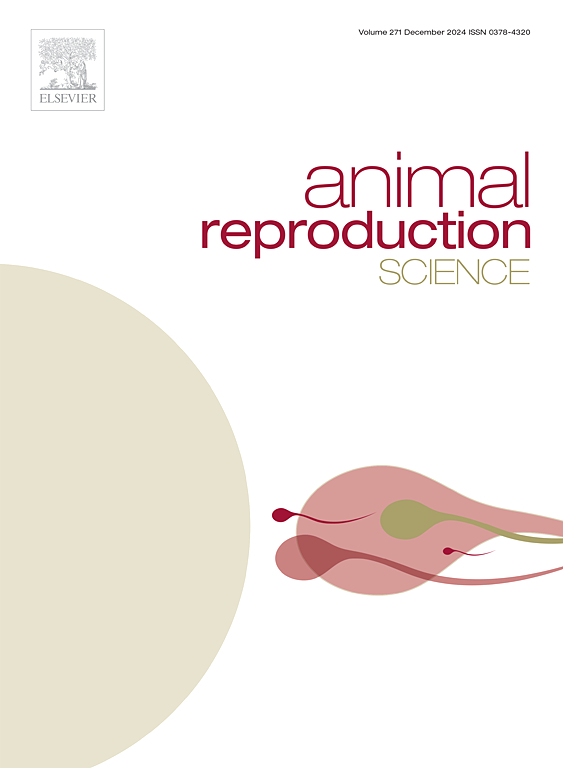牛睾丸热应激:从气候变化到对微RNA图谱的影响。
IF 3.3
2区 农林科学
Q1 AGRICULTURE, DAIRY & ANIMAL SCIENCE
引用次数: 0
摘要
热应激是由于动物暴露在高温高湿环境中,超出了其热舒适区而造成的。这会产生负面结果,包括对总体健康产生不利影响,降低生产和繁殖性能。在雄性动物中,热应激会破坏睾丸的体温调节,对精子发生产生有害影响,从而降低精子质量和生育潜力。因此,高环境温度被认为是导致公牛不育的最重要因素之一,并已成为许多研究的主题,尤其是在热带或亚热带国家。研究公牛睾丸热应激的影响、了解临床和精子发现的时间顺序以及了解潜在的病理生理学至关重要。此外,阐明涉及热应激和睾丸功能的分子机制可为选择耐热性更强的动物的有效循证策略提供依据。过热会影响精子中信使核糖核酸(mRNA)和微RNA(miRNA)的表达,而它们在调节雄性生育能力方面具有重要作用。根据目前的气候变化趋势,预计导致热应激的长期高温的发生率将会增加,给许多物种的健康和生存带来越来越大的风险。对 mRNA 和 miRNA 的研究可以为选择更能适应气候变化的动物提供有价值的见解。除了寻找耐热性更强的动物外,减轻热应激影响的其他策略还包括生殖生物技术和改善环境。本文章由计算机程序翻译,如有差异,请以英文原文为准。
Bovine testicular heat stress: From climate change to effects on microRNA profile
Heat stress is caused by exposure of animals to high temperatures and humidity, outside their thermal comfort zone. This can have negative outcomes, including adversely affecting general well-being and reducing productive and reproductive performance. In males, heat stress can disrupt testicular thermoregulation, with deleterious effects on spermatogenesis and consequently, decreases in sperm quality and fertility potential. Thus, high environmental temperature is considered one of the most important factors that predisposes bulls to subfertility and has already been the subject of many studies, particularly in tropical or subtropical countries. It is essential to study effects of testicular heat stress in bulls, know the chronology of clinical and sperm findings, and understand the underlying pathophysiology. In addition, elucidating molecular mechanisms involved in heat stress and testicular function could provide the basis for effective, evidence-based strategies for selecting more thermotolerant animals. Excessive heat affects expression of messenger RNA (mRNA) and microRNA (miRNA) in sperm, which have important roles in regulating male fertility. Based on current trends in climate change, the incidence of chronically high temperatures that cause heat stress is expected to increase, posing increasing risks to health and survival of many species. The study of mRNAs and miRNAs can provide valuable insights to select animals that are more resilient to climate change. In addition to the search for more thermotolerant animals, other strategies to mitigate effects of heat stress include reproductive biotechniques and promotion of a better environment.
求助全文
通过发布文献求助,成功后即可免费获取论文全文。
去求助
来源期刊

Animal Reproduction Science
农林科学-奶制品与动物科学
CiteScore
4.50
自引率
9.10%
发文量
136
审稿时长
54 days
期刊介绍:
Animal Reproduction Science publishes results from studies relating to reproduction and fertility in animals. This includes both fundamental research and applied studies, including management practices that increase our understanding of the biology and manipulation of reproduction. Manuscripts should go into depth in the mechanisms involved in the research reported, rather than a give a mere description of findings. The focus is on animals that are useful to humans including food- and fibre-producing; companion/recreational; captive; and endangered species including zoo animals, but excluding laboratory animals unless the results of the study provide new information that impacts the basic understanding of the biology or manipulation of reproduction.
The journal''s scope includes the study of reproductive physiology and endocrinology, reproductive cycles, natural and artificial control of reproduction, preservation and use of gametes and embryos, pregnancy and parturition, infertility and sterility, diagnostic and therapeutic techniques.
The Editorial Board of Animal Reproduction Science has decided not to publish papers in which there is an exclusive examination of the in vitro development of oocytes and embryos; however, there will be consideration of papers that include in vitro studies where the source of the oocytes and/or development of the embryos beyond the blastocyst stage is part of the experimental design.
 求助内容:
求助内容: 应助结果提醒方式:
应助结果提醒方式:


